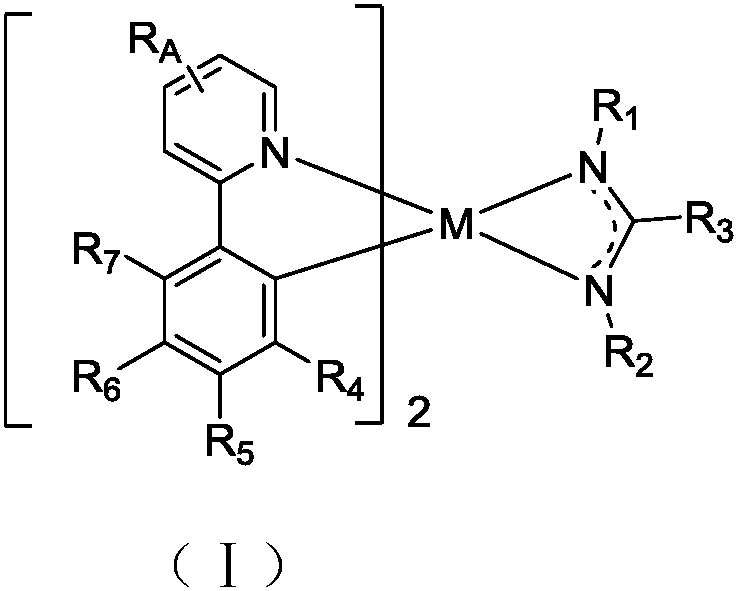Metal-containing organic complex and organic light-emitting device thereof
A technology of organic light-emitting devices and organic complexes, which is applied in the direction of indium organic compounds, platinum group organic compounds, compounds containing elements of Group 8/9/10/18 of the periodic table, etc., and can solve high-performance red phosphorescent materials Further development and other issues are needed to meet the needs of industrialization, easy to obtain raw materials, and low driving voltage.
- Summary
- Abstract
- Description
- Claims
- Application Information
AI Technical Summary
Problems solved by technology
Method used
Image
Examples
Embodiment 1
[0074] Embodiment 1: the preparation of compound 1
[0075]
[0076] Preparation of intermediate A1
[0077] Under nitrogen protection, compound a1 (7.15g, 30.7mmol) and compound b1 (3.77g, 30.7mmol) were added to a 100mL four-necked flask, and tetrakistriphenylphosphopalladium Pd (PPh 3 ) 4 (1.8g, 1.53mmol) and K 2 CO 3 (8.48g, 61.4mmol) was dissolved in toluene (150ml) and water (30ml). The mixture was then kept at 100°C overnight. After completing the reaction, the mixture was cooled to room temperature, and washed with brine and water, dried to obtain Intermediate A1 (6.28 g, yield 88%).
[0078] Preparation of Intermediate B1
[0079] In a 1L three-necked flask, iridium trichloride hydrate (14.11g, 40mmol) and intermediate A1 (39.49g, 170mmol) were added, then 300mL of 2-ethoxyethanol and 100mL of water were added, and the mixture was refluxed overnight under a nitrogen atmosphere. After the reaction, the temperature was lowered to room temperature, the precipit...
Embodiment 2
[0084] Embodiment 2: the preparation of compound 4
[0085] The b1 in Example 1 was replaced by equimolar b4, and the other steps were the same as in Example 1 to obtain the target compound 4 (4.99 g, 29%).
[0086]
[0087]Mass Spectrum m / z: 861.31 (calculated: 861.30). Theoretical element content (%)C 43 h 40 IrN 8 : C, 59.98; H, 4.68; Ir, 22.32; N, 13.01 Measured element content (%): C, 59.99; H, 4.67; Ir, 22.33; N, 13.00. The above results confirmed that the obtained product was the target product.
Embodiment 3
[0088] Embodiment 3: the preparation of compound 6
[0089] The b1 in Example 1 was replaced by equimolar b6, and the other steps were the same as in Example 1 to obtain the target compound 6 (5.00 g, 29%).
[0090]
[0091] Mass Spectrum m / z: 863.30 (calculated: 863.29). Theoretical element content (%)C 41 h 38 IrN 10 : C, 57.06; H, 4.44; Ir, 22.27; N, 16.23 The measured element content (%): C, 57.06; H, 4.43; Ir, 22.28; N, 16.23. The above results confirmed that the obtained product was the target product.
PUM
 Login to View More
Login to View More Abstract
Description
Claims
Application Information
 Login to View More
Login to View More - R&D
- Intellectual Property
- Life Sciences
- Materials
- Tech Scout
- Unparalleled Data Quality
- Higher Quality Content
- 60% Fewer Hallucinations
Browse by: Latest US Patents, China's latest patents, Technical Efficacy Thesaurus, Application Domain, Technology Topic, Popular Technical Reports.
© 2025 PatSnap. All rights reserved.Legal|Privacy policy|Modern Slavery Act Transparency Statement|Sitemap|About US| Contact US: help@patsnap.com



